Breastfeeding basics
This section outlines the basics of breastfeeding and explains what you can do to ensure your baby is feeding well and effectively. Whenever you feel breastfeeding-related difficulties or challenges arise, go back to these basics.
Over time, you and your baby will discover what works best for both of you.
Find the right time (signs of hunger)
It’s hard to get a baby to nurse if she’s asleep, she’s crying or she’s too hungry. As soon as you see signs that your baby is hungry, offer her your breast (see Hunger signs). That way she’ll be more patient.
Getting settled for a feed
Take the time to settle in with everything you might need during feeding (e.g., glass of water, snack).
Finding a breastfeeding position that is comfortable for you and your baby is essential for enjoyable, pain-free feeding.
If you are sitting, support your back and keep your spine and shoulders aligned. Your elbows should rest close to your body. You can use one or more cushions for support. Your feet should be flat on the floor or on a small stool.
Your baby’s body should be turned toward you and nestled against yours. Her head should be aligned with her body. Her hands should be on either side of your breast.
Position your baby so that her chin touches your breast, and your nipple is against her upper lip; this will make her open her mouth. Her head will be tilted back slightly, and her nose will be free of the breast.
There are several different breastfeeding positions. Here are some of them. You don’t have to master all the positions. One or two are often enough.
Laid-back position

Photos: Guillaume Brindamour
In this position, you are lying back far enough that your baby won’t slip off when lying on your stomach.
The laid-back (or back-lying) position can help babies latch onto the breast more effectively, slow the flow of milk if it flows fast, and be more comfortable for you and your baby.
Cradle position
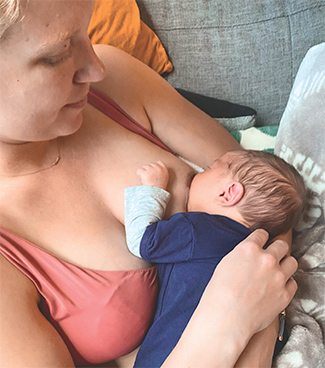
Photo: Guillaume Brindamour
In this position, you are seated. Your baby lies on her side, with her body facing you. You use the arm on the same side as the breast your baby is feeding from to support her body and head (e.g., if you are breastfeeding from the left breast, you support your baby with your left arm).
This position can be used to breastfeed anywhere.
Cross-cradle position
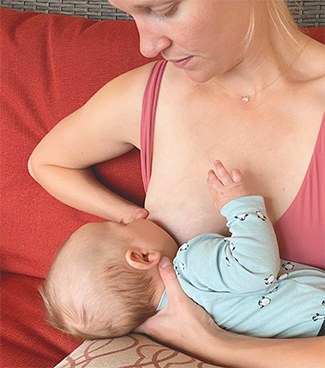
Photo: Guillaume Brindamour
In this position, you are seated as well. You support your baby’s body and head with the arm opposite the breast he is nursing from (e.g., if you are breastfeeding from the left breast, you support your baby with your right arm). The palm of your hand should be placed on his upper back, not on his head.
This position is often used in the early stages of breastfeeding. It can help your baby latch on to the breast better. Like the cradle position, the cross-cradle position can be used to breastfeed anywhere.
Lying-down position
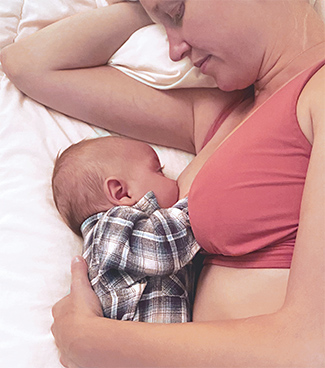
Photo : Guillaume Brindamour
In this position, you and your baby both lie on your side, facing each other. Your bodies are nestled against each other. You should offer the breast closest to the mattress. Your baby’s head should be placed at breast height.
Breastfeeding while lying down can be enjoyable and can give you a chance to rest. If you tend to doze or sleep while nursing, follow the recommendations in Sleeping safely to keep your baby safe.
Bringing baby to your breast
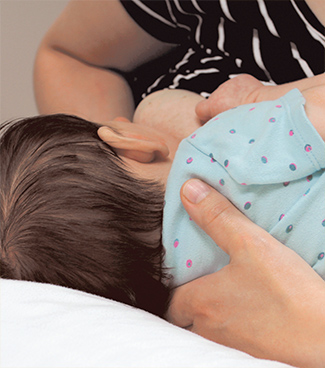
![]() Avoid putting pressure on the head with your fingers or the palm of your hand.
Avoid putting pressure on the head with your fingers or the palm of your hand.
Photo : Cécile Fortin
In the first few weeks of your baby’s life, feeling the breast near her mouth stimulates her reflex to open her mouth and latch on. You therefore need to hold your baby close enough so that her chin touches your breast.
Bring your baby to you instead of leaning towards her. This will be more comfortable.
Avoid putting pressure on her head with your fingers or the palm of your hand. Babies don’t seem to like this. They draw their heads back and some may have difficulty latching back on. If this happens, readjust your position.
During the first few days, you may have to start over several times to get your baby to latch on properly.
How to bring your baby to your breast

Photos: Jean-Claude Mercier
With time and practice, you and your baby will become more comfortable with breastfeeding. Latching on will get easier.
- Once both of you are settled, you’re ready to bring your baby to your breast.
When her chin touches your breast, place your nipple against her upper lip. - Wait till she opens her mouth wide. Your nipple should point toward her palate, not her tongue.
- When her mouth is open, guide her toward your breast by gently pressing against the top of her back with the palm of your hand:
- Her head should be tilted back slightly.
- Her chin should be firmly touching your breast and her nose should be clear.
Make sure your baby is latching on correctly
When your baby latches onto your breast, and not only the nipple, he will have a large part of the areola in his mouth. This makes it easier to get milk.
If your baby only sucks on the nipple, it can create pain for you, and she will get less milk. If this happens, some babies will ask to nurse very often, which irritates the nipples even more. Other babies get tired, cry or fall asleep before they’re full.
Signs of a good latch:
- You don’t have pain that lasts for the entire feeding.
- The baby’s mouth is wide open.
- He latches onto a part of the areola, and not just the nipple.
- His lips are curled outward.
- His chin should be firmly touching your breast and his nose should be clear.
Latching on shouldn’t be painful for you.
If you feel pain, you can try bringing your baby to your breast again by breaking the suction (see Breaking the suction). You can also try to improve your position (see Getting settled for a feed).
Is feeding still painful? Contact someone trained in breastfeeding and see Common difficulties.
Ensuring your baby is sucking effectively and swallowing milk
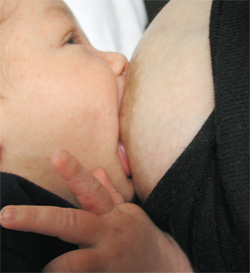
![]() If you experience painful nipples, try to improve the baby’s position and the latch. Latching on properly is the key to pain-free nursing!
If you experience painful nipples, try to improve the baby’s position and the latch. Latching on properly is the key to pain-free nursing!
Photo: Marie-Josée Santerre
When suction is effective, you can see jaw movements. When she first starts to nurse, the movements are quick and light. As milk starts flowing, the movements become slower and deeper. You can see and hear your baby swallow.
If your baby’s breathing is noisy during nursing, free up her nose by pressing her bottom against you to bring her chin closer to your breast. You can also gently press against the top of her back to bring her chin closer to your breast. Her nose should be freer or her head tilted slightly back.
Breaking the suction
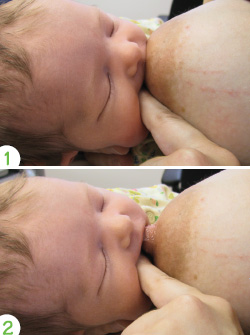
Photos: Marie-Josée Santerre
It’s important to break the suction properly when removing your baby from your breast, to avoid hurting your nipples. To break the suction
- Put your finger in the corner of your baby’s mouth to let air in.
- The nipple will release easily once the suction is broken.
Areola: Darker area of the breast around the nipple.


